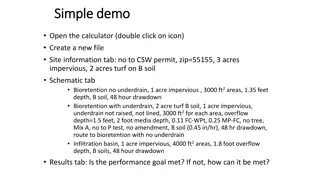DEVELOPMENT OF INTERATRIAL AND INTERVENTRICULAR SEPTUM
Human heart development begins in the 3rd week of gestation with the formation of heart tubes that eventually differentiate into various cardiac structures. The heart undergoes folding and septation processes during development, leading to the formation of crucial septa. Molecular regulation, involv
3 views • 62 slides
Best Management Practices (BMP) Program for Florida Agriculture
The Florida Department of Agriculture and Consumer Services implements the Agricultural Best Management Practices Program to improve water quality, conserve water, and protect the environment. BMPs are management strategies tailored to individual properties based on soil types, slope, water features
2 views • 6 slides
Pennsylvania's Agriculture-Linked Investment Program Overview
The Agriculture-Linked Investment Program (AgriLink Program) in Pennsylvania offers low-interest loans up to $25 million to assist farmers in implementing best management practices. The program provides benefits like a subsidized interest rate reduction for construction projects and is funded throug
2 views • 22 slides
EMC Tar-Pamlico Phase IV Agreement Water Quality Committee Details
The EMC Tar-Pamlico Phase IV Agreement entails nutrient control for Tar-Pamlico point sources initiated in 1990. The agreement focuses on performance goals, funding, BMPs, and management strategies. It addresses parties, basin association members, and key changes in the Phase IV agreement. Various a
0 views • 10 slides
Best Practices for Water Management in Agricultural Settings
Exploring various Best Management Practices (BMPs) for water management in agriculture, this content delves into definitions of detention and retention, EAA farm P load calculations, rainfall detention BMP goals, water detention methods, and mixed crop rotation strategies. The information covers red
1 views • 21 slides
The MIDS Calculator for Stormwater Management
The MIDS Calculator is an Excel-based tool that helps quantify stormwater runoff volume reduction and pollutant removal for Best Management Practices (BMPs). It can assist in selecting and sizing BMPs to meet regulatory or water quality objectives. Despite some limitations, it is widely used and off
0 views • 14 slides
Chesapeake Bay Program Watershed Model Overview
The Chesapeake Bay Program's Watershed Model, presented to STAC in December 2019, provides insights on long-term average pollutant loads and land use dynamics in the Chesapeake Bay watershed. The model incorporates inputs such as land use acres, BMPs, and delivery mechanisms to estimate pollutant lo
0 views • 41 slides
Conservation Efforts for Migratory Birds in Southern Cone Grasslands
The Southern Cone Grasslands Alliance focuses on conserving migratory birds in the threatened Pampas Grasslands by working with landowners, promoting traditional grazing practices, and developing sustainable ranching methods. Since 2005, BirdLife partners have been collaborating to encourage best ma
0 views • 11 slides
Stormwater Management and Best Management Practices
Stormwater management is crucial for protecting our environment from pollutants in runoff water. Best Management Practices (BMPs) are a combination of structural, vegetative, and managerial techniques used to prevent water pollution and improve water quality. Learn about stormwater pollution, minimu
1 views • 15 slides
Economic Analysis of Water Table Management: Insights and Barriers to Adoption
An overview of the socio-economic analysis of water table management in agricultural practices, including major findings from field studies, barriers to adoption, and factors influencing the adoption of Best Management Practices (BMPs) among producers. The study highlights the economic motivations,
0 views • 17 slides
Sustainable Water Management Project in Orange County
This project involves implementing alternative compliance measures focusing on water retention and quality credits through the use of Low Impact Development Best Management Practices (LID BMPs) in the Fletcher Basin Watershed. The initiative aims to enhance water supply augmentation, sustainable lan
0 views • 11 slides
Statewide NPDES Permit for Drinking Water Systems Workshop
Implementation workshop on the Statewide NPDES Permit for Drinking Water System Discharges. Details enrollment requirements for water purveyors, authorized discharges types, and effluent requirements. Includes BMPs, effluent limitations, and discharge compliance criteria for various water systems. T
0 views • 26 slides
Stormwater Management Calculator Overview
Explore the functionalities of a stormwater management calculator that helps in analyzing stormwater runoff, pollutants, and BMP efficiencies. Learn about different BMP types, performance goals, and annual pollutant reduction targets to achieve effective stormwater management. Understand how the cal
0 views • 14 slides
Enhancing Watershed Nutrient Response and Climate Resilience
The Watershed Group aims to enhance nutrient response to flow and sediment changes, improve N and P speciation, and integrate climate change effects into BMP effectiveness estimates. Strategies include spatially varying N relationships, investigating WWTPs and stormwater systems, and reviewing speci
0 views • 7 slides
Dental Amalgam Control Program Overview and Best Practices
The Metro Wastewater Reclamation District has implemented a Dental Amalgam Control Program to regulate all dental facilities within its service area. This program covers Best Management Practices (BMPs), Amalgam Separator Installation, Operations and Maintenance (O&M) requirements, Record Keeping, a
1 views • 32 slides
Sustainable Agricultural Practices and Technology Transfer Plan
The Socio-Economic Work Plan for AGGP II focuses on the partial budgeting of beneficial management practices related to water management systems, GHG mitigation, and adaptation. It aims to identify co-benefits, assess socio-economic factors affecting water demand and climate change, develop a region
0 views • 19 slides
MIDS calculator
Quantify runoff volume reductions and phosphorus/TSS removal for BMPs using the MIDS calculator. Understand how it works, why it's essential, and explore various BMP options like bioretention basins, permeable pavement, and more. Address specific scenarios to optimize BMP selection for managing stor
0 views • 12 slides
MIDS Calculator - Stormwater Runoff Reduction Tool
The MIDS Calculator is an Excel-based tool that quantifies reductions in stormwater runoff volume, phosphorus (P), and total suspended solids (TSS) for specific Best Management Practices (BMPs). It helps select and size the best BMPs for a particular situation based on performance goals. Learn how t
0 views • 12 slides

















